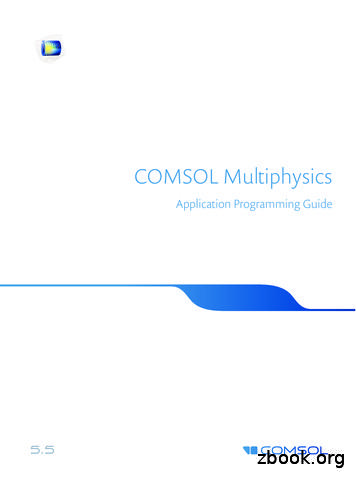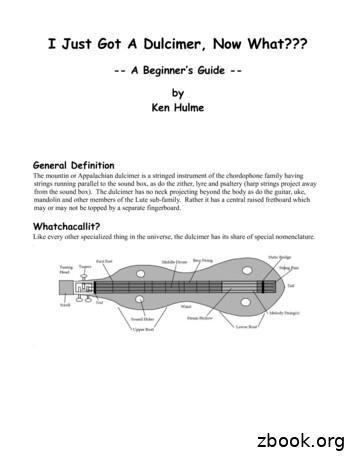Introduction To R: Basic String And DNA Sequence Handling
Introduction to R: Basic string and DNA sequence handlingManuela Benary and Pål O. WestermarkStrings and other data structuresSo far, we have concentrated on numerical data. However, can we store characters too? Let’s try working with thealphabet of the DNA. In this section we will search for occurences of the hormone response element in the promoter ofa gene.nucleobase - Tprint(nucleobase)## [1] TRUEnucleobase - "T"print(nucleobase)## [1] "T"Here in the first example, the variable ’nucleobase’ will have the value ’TRUE’. ’T’ and ’F’ are the short form for boolean’TRUE’ and ’FALSE’. So, as you can see, characters need to be surrounded by quotation marks (””). We can comparedifferent strings with ’ ’, and test whether they are identical.nucleobase "T"## [1] TRUEnucleobase "A"## [1] FALSEBase complementPlease write a function ’basecomp’ to translate nucleotides into their complement.If you considered all cases, testing your function would give you something likebasecomp("A")## [1] "T"basecomp("T")## [1] "A"basecomp("P")## Warning in basecomp("P"):You have entered an invalid baseBut there’s an easier way. Let’s create a vector of the bases (similar to a vector of numbers)thebases - c("A", "C", "G", "T")thebases[2]## [1] "C"names(thebases)1
Introduction to R: Basic string and DNA sequence handling2## NULLnames(thebases) - c("T", "G", "C", "A")thebases["C"]##C## "G"Each element in a vector can be accessed either by an index or by giving the element a name. The function ’names’assigns the names for the individual elements of a vector.Of course, we can store also whole sequences of characters. One example is the sequence of the hormone responseelement, which can be bound by the activated steroid receptor and thus initiates gene expression (Figure 1). A secondexample is the TATA-box, which can be found in the core promoter region of 10–20% of human genes. We can combineBioinformaticsSSa20148differentstrings- invector as well:Figure 1:eukaryotic corecore promoterpromoter includingincluding thethe TATA-boxTATA-box andand thethe(dimeric)(dimeric)bindingbindingsitesite3: A hypothetical example of an eukaryoticof a hormone receptor.hre - "AGGTCA"print(hre)nucleobase "A"## [1] "AGGTCA"## [1] FALSEdnaseq - c(hre, "TATAAA")print(dnaseq)##Base[1] complement"AGGTCA" "TATAAA"Please write a function ’basecomp’ to translate nucleotides into their complement.print(dnaseq[2])## If[1]you"TATAAA"considered all cases, testing your function would give you something likeWe can easily split strings using a separating character and we will end up with a list of characters. A list can hold allbasecomp("A")types of different things. The list is your first encounter with a data structure. Lists work like boxes within boxes. If wehavea vector## [1]"T" of strings, the result for each string will be added as a new element in the list. Each element in the listcan be accessed via [[]] (mind the difference: for vectors only one bracket is necessary).basecomp("T")dnabases - strsplit(dnaseq, split NULL)print(dnabases)## [1] "A"## [[1]]basecomp("P")##[1] "A" "G" "G" "T" "C" "A"#### [[2]]Warning: You have entered an invalid base#### [1] "T" "A" "T" "A" "A" "A"But there’s an easier way. Lets create a vector of the bases (similar to a vector of numbers)print(dnabases[[1]])thebases -"G"c("A","G","A""T")##[1] "A""G" "C","T" "C"thebases[2]dnabases[[2]] - 11print(dnabases)## [1] "C"names(thebases)## NULLnames(thebases) - c("T", "G", "C", "A")
Introduction to R: Basic string and DNA sequence handling##########3[[1]][1] "A" "G" "G" "T" "C" "A"[[2]][1] 11Here, we used a named argument, ’split’. This tells us at which characters we want to split our strings. If set to NULL,like above, this means splitting between all characters. As you can see, you can mix numbers and characters in your listand R will not complain. If we want to get the complement of the HR-element, we can use the function ’basecomp’from before and apply this function to each nucleotide in our sequence. One way is using a for-loop again (if you do notfeel confident yet, give it another try). However, the better way (faster and efficient) is to use the function ’apply’, inparticular ’lapply’. ’l’ stands for ’list’ here. A general overview of apply-functions in R can be found at Neil SaundersBlog.dnacomplist - lapply(dnabases[[1]], basecomp)print(dnacomplist)You got back a list, but this is not the easiest way to handle strings. Let’s use ’sapply’ (’s’ stands for ’simplify’), whichyou already have encountered:dnacompvec - sapply(dnabases[[1]], basecomp)print(dnacompvec)Lists and vectors Print the third element of ’dnacompvec’ and of ’dnacomplist’. Are they the same? Use the vector ’thebases’ to define the complement of the first element of ’dnabases’. Remember, you can usea vector to access elements of a vector.In general, DNA sequences are stored as a single strand. If we want to find occurences of the HRE we have to considerthe original pattern as well as the reverse complement: in general proteins can bind to any string, sometimes even in anyorientation. We already know how to generate the complement, but we need to reverse the sequence to generate thereverse complement.1:5## [1] 1 2 3 4 5rev(1:5)## [1] 5 4 3 2 1dnaseqcompt - ompt, collapse "")## [1] "TGACCT"(There are other ways too to reverse, index, and slice vectors, but we cannot cover all here.)Reverse complementWrite a function ’revcomplement’, which returns the reverse complement of a given DNA sequence.Testing the function with the HR-element should result in the following.revcomplement(hre)## [1] "TGACCT"Finally, we have the building blocks to actually search for occurences of the hormone receptor element. We will use the
Introduction to R: Basic string and DNA sequence handling4promoter of the gene ’Prdx1’ as an example here.Download a gene sequenceGo to genome.ucsc.edu and download 3000 bp upstream of the transcription start site of the gene ’Prdx1’. Genome Browser, select Mammal / Mouse / mm10, type Prdx1. Click blue box with prdx1, upper left GenomicSequence. Select only Promoter/Upstream, fill in 3000 bases. One FASTA record per gene. Check All upper case,uncheck mask repeats. Save as/Speichern unter choose name prdx1.fa and format Text. Choose the samedirectory as your R working directory, which you obtain with getwd().We will now read the sequence from the file line by line and store these in a vector. The first line should be the header,which we do not keep. And we will collapse the array of strings into one gigantic string.rawseq - readLines("prdx1.fa")prdx1arr - rawseq[2:length(rawseq)]prdx1seq - paste(prdx1arr, collapse "")You can check whether everything went right by counting the number of characters in your string using the functionnchar(). We are now going to write code to count the occurences of a given string in this DNA sequence. As alwaysin good engineering tradition, we approach the problem by creating small building blocks, which we later combine toachieve our goal. The first building block is a function for picking out substrings:substr(prdx1seq, 1, 2)## [1] "TG"Substrings Extract the bases from position 4 to 9. Using substr and nchar, extract the last 6 bases of the prdx1 gene.If we want to look for occurrences of the motif AGGTCA, we need the motif (should be stored as ’hre’) and its reversecomplement.comp.hre - revcomplement(hre)comp.hre## [1] "TGACCT"len - nchar(hre)Next, we want to extract all (overlapping) substrings of the length of the motif (’len’) in our sequence, which would bea reoccuring use of the function ’substr’: substr(prdx1seq, 1, len)substr(prdx1seq, 2, len 1).substr(prdx1seq, nchar(prdx1seq) - (len - 1), nchar(prdx1seq))This looks similar to the for-loop (or even easier an apply-function) we have used before. So let’s do this systematically:We need the starting index and the ending index for the substring. We need to be real careful at the end of the genesequence to make sure that the substring is as long as the motif.leftlims - 1:(nchar(prdx1seq) - (len - 1))rightlims - len:nchar(prdx1seq)substr() is a function which has two arguments, therefore we cannot use the simple ’apply’. However, we can use’mapply’ to apply a function to each element of multiple arguments (see Figure 2]).
BioinformaticsSSBasic2014 string and DNA sequence handlingIntroduction to- R:115Figure 4: Disecting a large sequence into a vector of overlapping fragments using the function ’mapply’.Figure 2: Dissecting a large sequence into a vector of overlapping fragments using the function ’mapply’.substr(prdx1seq, 1, 2)prdx1substrings - mapply(substr, prdx1seq, leftlims, rightlims,USE.NAMES FALSE)## [1] "TG"head(prdx1substrings)## [1] "TGATGA" "GATGAC" "ATGACC" "TGACCT" "GACCTG" "ACCTGA"SubstringsWe combined ’substr’ and ’mapply’ to split our sequence into a vector of overlapping fragments. The next step is acheck whetherfragmentis a hit.This 4checkExtractathebases frompositionto 9.should be written as a function as it is to be reused multiple times.Usingsubstrandnchar,extractthelast 6 baseshitcounter - function(fragment, themotif){ of the prdx1 gene.if (fragment themotif)If return(1)we want to look for occurrences of the motif AGGTCA, we need the motif (should be stored as ’hre’) and its reverseelsecomplement.return(0)}comp.hre - revcomplement(hre)comp.hreThe if-else-statement can be written in a shorter way using the function ’ifelse’. This function condenses the returnstatementsinto one function.##[1] "TGACCT"occurences of HRElenFinding - nchar(hre)Next, we want to extract all (overlapping) substrings of the length of the motif (’len’) in our sequence, which would Test your function ’hitcounter’ with fragment number 1 and 4.be a reoccuring use of the function ’substr’: Try writing a shorter version of ’hitcounter’ using ’ifelse’ (if you are not sure what to do, use the help pagessubstr(prdx1seq, 1, len)of R/RStudio).substr(prdx1seq, 2, len 1) Extend your function ’hitcounter’ to search for the reverse complement as well. Test your function again with.fragment number 1 and 4.substr(prdx1seq, nchar(prdx1seq) - (len - 1), nchar(prdx1seq)) Bonus: What happens if you give your function ’hitcounter’ your complete vector instead of one element?This looks similar to the for-loop (or even easier an apply-function) we have used before. So, let’s do this systematically:We need the starting index and the ending index for the substring. We need to be careful at the end of the gene sequence,So, weourisownbuildingblockthat returns a 1 whenever a fragment matches a given motif. If we now apply thisthatthecreatedsubstringas longas themotif.function to all our fragments, we obtain a vector with mostly 0’s and a few 1’s, as seen in the last exercise. If we sumleftlims - 1:(nchar(prdx1seq)- (len - 1))these numbersup .rightlims len:nchar(prdx1seq)scores - hitcounter(prdx1substrings, hre)nhits - sum(scores)’Substr’ is a function which has two arguments, therefor we cannot use the simple ’apply’. However, we can usenhits’mapply’ to apply a function to each element of multiple arguments (see Figure 4]).## [1] 3prdx1substrings - mapply(substr, prdx1seq, leftlims, rightlims,. we get the total number of hitsin our sequence. As we may want to use that in other sequences or with other motifsUSE.NAMES FALSE)as well, we will wrap everything up in a function called ’counthits’head(prdx1substrings)## [1] "TGATGA" "GATGAC" "ATGACC" "TGACCT" "GACCTG" "ACCTGA"
Introduction to R: Basic string and DNA sequence handlingcounthits - function(sequence, motif) {compmotif - revcomplement(motif)len - nchar(motif)leftlim - 1:(nchar(sequence) - (len - 1))rightlim - len:nchar(sequence)frags - mapply(substr, sequence, leftlim, rightlim, USE.NAMES FALSE)scores - ifelse(frags motif frags compmotif, 1, 0)return(sum(scores))}6
Introduction to R: Basic string and DNA sequence handling 5 Bioinformatics - SS 2014 11 Figure 4: Disecting a large sequence into a vector of overlapping fragments using the function ÕmapplyÕ. substr (prdx1seq, 1, 2) ## [1] "TG" Substrings Extract the bases from position 4 to 9. Using substr and nchar, extract the last 6 bases of the prdx1 gene.
You can also tune your guitar to a keyboard or piano. The open strings of a guitar correspond to certain notes on a keyboard. SESSION 1 3 Starting Off Right Learn &Master Guitar E A D G B E B 6th string 5th string 4th string 3rd string 2nd string 1st string 5th Fret 1st string 6th string 5th string 4th string 3rd string 2nd string E A D GB E .
You can also tune your guitar to a keyboard or piano. The open strings of a guitar correspond to certain notes on a keyboard. SESSION 1 3 Starting Off Right Learn &Master Guitar E A D G B E B 6th string 5th string 4th string 3rd string 2nd string 1st string 5th Fret 1st string 6th string 5th string 4th string 3rd string 2nd string E A D GB E .
Barber, Samuel String Quartet No.1, Op.11 Bartok, Bela String Quartet No.2, Op.17 String Quartet No.4 Beethoven, Ludwig van String Quartet No.1 in F major, Op.18 No.1 String Quartet No.2 in G major, “Compliments” Op.18 No.2 String Quartet No.6 in B-flat major, Op.18 No.6 String Quartet No.7 in F major, “Rasumovsky 1” Op.59 No.1
String Quartet n. 15 op. 144 Anton Webern String Quartet op. 28 Five Movements for String Quartet Six Bagatelles for String Quartet Alexander Von Zemlinsky String Quartet n. 2 op. 15 2) Toshio Hosokawa UTA-ORI. Weaving Song for string quartet (2020) New composition for String Quartet
Alternatively, you can use the operator as follows: a a b; which is equivalent to: a "string A" " and string B"; and equivalent to: a "string A" " " "and string B"; where the middle string is a string with a single whitespace character. Comparing Strings Comparing string values in
query string. Given a query string and a string tuple , the similarity score of and in this class of predicates is of the form weight of the token,where is the query-based in string and weight of the token is the tuple-based in string . 3.2.1 Tf-idf Cosine Similarity The tf-idf cosine similarity [24] between a query string and a string tuple
3 string 4 string (double melody) 5 string (double melody and bass usually) 6 string (every course doubled). Doubling a string provides more volume for the notes sounded on that string compared to the notes on the other courses. Another string arrangement seen among more advanced players
Barber: Serenade for string quartet Roussel: String Quartet Les Vendredis Weill: String Quartet Malipiero: String Quartet No. 1 Skalkottas: String Quartet No. 4 4. Introduction to the First Edition This eBook was written to address the following situation: there are many, many






















